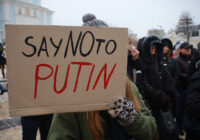Ukraine has been experiencing a national rebirth since the Russian invasions in 2014 and 2022. Nationalist discourses centered on questions such as “What is Ukraine?” and “Who are Ukrainians?” permeate discussions with the goal of creating a new national historical narrative.
Every nation-state in Europe has such a national historical narrative. Everyone has been taught about the people and events that built their nation. Perhaps most importantly, these narratives determine what lands and people belong within the state. For younger nations, this process resonates strongly in people’s minds. Most other European nations, however, established their own narratives long ago.
A frenzy is taking place among students, academics and intellectuals looking to rewrite the course of Ukrainian history in a way that empowers an independent, European Ukraine and, above all, denies Russia’s claims over its territory. This situation is highly understandable. After all, to justify his invasion Vladimir Putin concocted his own historical narrative about Ukraine. His long-winded article “On the Historical Unity of Russians and Ukrainians,” written in mid-2021, depicted Ukraine (and Belarus) as culturally inseparable from Russia. For Putin, his piece serves to delegitimize Ukrainian nationhood and justifies Russia’s right to intervene. For Ukraine, refuting Putin’s narrative is paramount. However, the history of Ukrainian territory as a junction for cultural and political exchanges makes this an intricate task.
Caught between empires
As the American historian Timothy Snyder impressively illustrated over a 23-part lecture series in 2022 (all available on Youtube), throughout the last 2000 years up until the mid-20th century, different parts of Ukraine came under the control of different countries at different times. Despite this, three important periods stand out in Ukrainian history, which the country could draw upon to be cornerstones of its national story. Chronologically, these periods are Kievan Rus’ (c. 880–1240), the Polish-Lithuanian Commonwealth (1569–1795) and Austrian Galicia (1772–1918). This complexity means that drawing one narrative from one part of Ukraine may negate another narrative from another part. For example, stating that Crimea and Donbas belong to the modern Ukrainian nation, while also claiming a common history with Poland leads to difficulty. Identifying one single narrative of Ukrainian nationhood that encompasses all of contemporary Ukraine’s recognized borders is impossible.
Starting in the Middle Ages, the story of Kievan Rus’ marks the first major European state ruled from Kyiv. It was huge, stretching from the Black Sea to Finland, and was founded by Norsemen. This period saw the East Slavic peoples adopt Orthodox Christianity. However, as a pan-East Slavic state, its legacy is too closely shared with modern Russia to function as Ukraine’s main national origin story. At that time, the East Slavic peoples were much closer than they are today; they all spoke similar dialects and had similar customs. Crucially, Putin himself is currently using this story to justify his own narrative on Russian and Ukrainian unity.
Another period in question is Austrian Galicia, where a part of western Ukraine came under Habsburg control as part of the Austrian and later Austro-Hungarian empire. For the time, the region had considerable autonomy, and much Ukrainian nation-building, such as newly distinct Ukrainian literature, took place during this time and space. However, since most of modern-day Ukraine lay in the Russian empire during that time, Austrian Galicia was too small to be used as the main historical cornerstone for the whole Ukrainian nation.
This leaves the period of the Polish-Lithuanian Commonwealth. Another vast state stretching from the Baltic Sea almost to the Black Sea, the Commonwealth encompassed much of modern-day western and central Ukraine, Belarus, Lithuania and Poland. Nominally a union between the Kingdom of Poland and the Grand Duchy of Lithuania, towards the end of the period the state was also an early example of a constitutional, elected monarchy, characterized by great internal diversity. Indeed, most may not know that the state adopted Europe’s first written constitution — the May 3, 1791 Constitution — soon after the American and French Revolutions. Equally important is how the state met its end; between 1772 and 1795 the Commonwealth was carved up and partitioned by the absolutist monarchs of Prussia, Austria and Russia. Ukrainian lands were divided between the latter two. Poland and Lithuania would not exist as independent states again for another 124 years.
Lessons from the Commonwealth period
But where does Ukraine lie in all this? As an integral part of the Commonwealth, Ukrainians, referred to as “Ruthenians,” enjoyed certain religious freedoms, and Ruthenian lands and nobility were recognized as distinct and equal in rights to their Polish and Lithuanian counterparts. They were incorporated into a (proto) democratic European state, enabling them to draw on a legacy of Europeanness and democracy, but also victimhood at the hands of imperial Russia, by whom they were annexed. Whereas until 2014 Ukraine had been firmly tethered to Russia from a historical perspective, from this view Ukrainian history can be anchored externally in another neighboring country— Poland. As a modern, prosperous democracy in the EU, Poland’s success is what Ukraine also aspires for.
By granting Ukraine a degree of ownership of the legacy of the Polish-Lithuanian Commonwealth, Poland will also benefit. Instead of another pro-Russian autocracy, like Belarus, Poland will have a friendly, democratic neighbor between it and Russia. Poland’s own history of Ukrainian oppression during the interwar period, perhaps its most painful source of historical guilt, will be overlooked in favor of common history and values. An example of this that comes to mind is when Poland and Ukraine co-hosted the UEFA Euro 2012 football championship, whose literal motto was “Creating History Together.” More recently, Poland’s overwhelming support for Ukraine has seen it take in millions of Ukrainian refugees and supply Ukraine with significant military and financial resources.

Maximum extent of Polish-Lithuanian Commonwealth, c. 1619. Via Samotny Wędrowiec on Wikimedia Commons (CC BY-SA 3.0).
Shifting narratives westward
What does this rethought historical narrative mean for Ukraine’s future? First and foremost, by cutting threads with Russia, Soviet and imperial Russian history will be viewed through the lens of occupation and oppression, but also Ukraine’s overall triumph. Meanwhile, the linkage with Poland (and Lithuania) has worked to convince Ukrainians and other Europeans of Ukraine’s rightful place in European institutions (mainly the EU), bestow it with some valuable democratic credentials, and hopefully secure it from future Russian aggression by building solidarity with the rest of Europe. Outside of this Commonwealth legacy, importantly, are Crimea and southeastern Ukraine — areas currently under Russian occupation — as these lands never came under Polish rule.
Historical narratives are used in every country in the world to achieve societal harmony as well as political goals. Ukraine is no different. To pursue a European path it is necessary to convince people of Ukraine’s “Europeanness.” By emphasizing cultural and historical ties to Poland and EU values of democracy and tolerance, Ukraine is succeeding in pegging its tent in the European camp.
[Stephen Chilimidos edited this piece.]
The views expressed in this article are the author’s own and do not necessarily reflect Fair Observer’s editorial policy.
Support Fair Observer
We rely on your support for our independence, diversity and quality.
For more than 10 years, Fair Observer has been free, fair and independent. No billionaire owns us, no advertisers control us. We are a reader-supported nonprofit. Unlike many other publications, we keep our content free for readers regardless of where they live or whether they can afford to pay. We have no paywalls and no ads.
In the post-truth era of fake news, echo chambers and filter bubbles, we publish a plurality of perspectives from around the world. Anyone can publish with us, but everyone goes through a rigorous editorial process. So, you get fact-checked, well-reasoned content instead of noise.
We publish 2,500+ voices from 90+ countries. We also conduct education and training programs
on subjects ranging from digital media and journalism to writing and critical thinking. This
doesn’t come cheap. Servers, editors, trainers and web developers cost
money.
Please consider supporting us on a regular basis as a recurring donor or a
sustaining member.
Will you support FO’s journalism?
We rely on your support for our independence, diversity and quality.








Comment